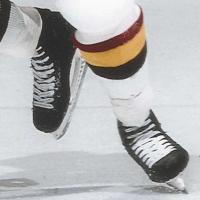Slate
Blackcurrant
Watermelon
Strawberry
Orange
Banana
Apple
Emerald
Chocolate
Marble
Slate
Blackcurrant
Watermelon
Strawberry
Orange
Banana
Apple
Emerald
Chocolate
Marble
-
Content Count
2676 -
Joined
-
Last visited
-
Days Won
72 -
Feedback
0%
Content Type
Profiles
Forums
Downloads
Gallery
Store
MSH News and Articles
Everything posted by flip12
-
Some guys I play with ordered Backstroms. They look more like p19 curves with a thinner blade face than anything P88 or PM9.
-
But I thought P14 had the radiused toe for increased ice contact on toe-initiated shots. P88 might have the flattest toe rocker of any retail blade ever.
-
Anyone got a non-FB source?
- 41 replies
-
- fizix frames
- suspension frames
- (and 3 more)
-
I think it’s tape. Customs are built like papier-mâché and there’s tape holding the build up to the footlast.
-
Speaking of, that reminded me of this gem:
-
2012 I think Easton released the E28, with the others following up with it more or less reluctantly due to demand. So yeah, going on 10 years of widespread availability. What’s a combo blade?
-
The curve doesn’t pass the puck, the player using it does, so whether a curve is good or bad for passing or any other particular facet of stick skills is entirely dependent on how well it correlates with what the preferences of the one who’s wielding it. I personally like P28 for passing because of the toe-heavy pocket as well as the heel curve and loft combo which makes heel-to-mid-blade saucers very easy. P28’s definitely not for everyone though. While it’s not my favorite passing pattern of all time it’s easily my favorite of what’s readily available these days.
-
Bauer P14 is very rockered at the toe. Closer to P28 than P88 in that area. P89 might be interesting for you if you can find it. It’s a bit more open than P88. Easton’s version was even a bit more open than that. It’s a beautiful curve but it’s subtle, so it’s never taken off at retail.
-
They’re very close though, so even if the CCMs are taller, the difference is a lot less than I thought from my first post. Have you compared how high they come up on your leg out of curiosity? That would be a little more accurate for showing how close they are. Measuring from the outside is a decent indicator, but there can still be a few mm of height difference due to the stack from the bottom of the foot to the outsole. Looking at how high they come up on you exposes their effective height rather than their apparent height.
-
Huh, interesting. Do the top eyelets on the Trues come up higher on your leg? It's hard to see an exact comparison from your picture due to the perspective angle, and it looks like some of it could be the subtraction CCM's made to the back of their retail boots in recent iterations. I didn't realize CCM dropped their boot height that much. I thought they used to be taller internally.
-
True can get away with a tighter wrap because they're lower cut. Higher cut boots have to flare out to allow for ankle ROM without scraping away the soft tissue of the ankle. The skate is meant to hold that shape at all costs--that flare is in large part the essence of what it is, design-wise. I haven't tried to do it, but my guess would be you'll dislike the softness you'll need to induce in the shell to achieve the wrap you're after. Kovalchuk has it in his Vapors, but they're Nylon/tech-mesh, not CURV, fibreglas, or composite like contemporary skates are, and I'd bet he deliberately creases them to hell upon baking them to achieve the flex X wrap he wants, because you see it in his Return Of The Kovy era NHL skates that look relatively new.
-
That's also a possibility. But one that I consider sometimes, not assume. However, from the anecdotes I've picked up, it seems like those experiments used to branch out in an idiosyncratic evolution. Once in a while, others would hop onto what they saw their buddies using: Yzerman going for Sakic's curve even though Yzerman's own was probably the most used in the NHL at the time, for example. Grant Marshall (I think it was) using Brett Hull's spec, Malkin picking up various patterns from teammates, from Pouliot's stock P88 to Galchenyuk's family's secret sauce pattern. Sometimes you see players start with something and then do pretty much the same thing to it, like Ryan Smyth almost ending up with a mirrored Kovalchuk at the end of his career--except that Smyth was still using wood blades and didn't add the toe shave to his (if not exact, very close to) E4 he was curving. The potential permutation space is vast, yet it's still likely there have been several instances of two players recreating the same thing separately, but in any case, anecdotes I've heard of usually involve one player completely abandoning his stick design evolution branch for another.
-
I'm thinking autocorrect put Brett instead of Brent Burns. BB still looks to be using the Gionta that he's sworn by for years now, which was also Big Mac's go to before going to the P92 he's on now. Barzal used it for a couple of years as well. I've wondered about the P28 origin. Bjugstad also claims to have invented it, of course. Some say it was Kreps, some say it was Ovechkin or Fisher. We need a proper oral history of this thing because as usual there are conflicting claims, as there are with the Sakic. Sakic said he created it but H. Ghassemi claims to have introduced it to Easton because he couldn't shoot with any of the curves they had in the era of making the T-Flex into the Synergy (he was a product guy there and the original he says the original retail Sakic was his custom curve he had on some Sher-Woods). I've looked through the images of Kreps on Getty and it looks like he went back and forth between Kovalchuk and Ovechkin patterns before settling on the E28. Those two actually make sense as potential inputs to making the E28. Ovechkin's basically got the E6 with a slightly more mid-focused second pocket. Kovalchuk had the E4 with the toe curve closer to the location of the E28 pocket and a focused toe shave for puck-ice-blade contact. E28 is kind of a blend of those two. Fisher started using the E28 around the same time though, IIRC. It could be Kreps switched to that after having tried something to either side of it and never looked back. If that were the case, it would seem weird Easton put his number on it, since Fisher was an even more dedicated Easton stick user. They need to get Fisher on one of the hockey podcasts and open up for audience questions so we can some inside perspective.
-
There are plenty of forwards using P28 too. I don't know statisticks on it or anything, but I can think of a lot of notable players using P28. Then there's the Oates effect where he funnels a lot of players to Stamkos' P92 variant, or something close to it. Funnily enough, Stammer's actually gone the other way, using P28 the last few years. When it comes down to it, P28 and P92 are more alike than they are different. Both 1) have a decent amount of loft without being obscenely open, 2) are compound heel-and-toe curves, 3) with a flat(ter) heel rocker and more aggressive toe rocker. The toe shapes are different of course, and the discontinuity of the heel-to-toe rocker is a bit more pronounced on P28, but to me, the main difference is the gravitational center of the compound curve pocket is at the heel of the P92 and at the toe of the P28. That's the thing I love about the P28 that I was missing until it came on the scene--the toe-dominant pocket. The aggressiveness of the standard heel curve that formed the basis of most of the patterns of yore threw me off. Sher-Wood Coffey and Montreal PC were some exceptions, P89 as well (when you could find it), with a few other short-lived Warriors like the Smyth and Gionta were some notable exceptions. If only Bjugstad had made the P46 a blend of the E4 blade face with the P28 curve instead of the P92, I could call it a day and never have to think about curves ever again. As it is, the P28 works about as well as anything I've ever had my hands on when the balance is right.
-
P28 is a great passing curve, just like its predecessor, Easton Drury/E6. The toe modifications don’t take the Drury away; just add a little party to the tail end.
-
I'm leaning towards putting heel lifts on mine. I like the holder, but I feel like I'm not forward enough, especially on starts. My favorite holder and steel spec has been the classic Graf Cobra 11' radius with aggressive pitch. Does anyone have a suggestion on how much of a heel lift I should request to achieve that feel on my Cat7s?
-
A. Yes (96% sure). C. No (100% sure: Shift and Shift Max are the only switch holders I’m aware of—that is a Shift (Max) holder is one shape that goes on a left or right skate whereas the others have a left holder and a right holder and they can’t mix and match holder sides and skate sides, so they’re not going to line up with the Shift (Max) holes). B. Sounds right but I can’t remember the specifics.
-
Sorry, I meant the new runners, not holders.
-
How much do the new holders weigh compared to the old ones?
-
Bauer keeps experimenting with weight reduction on the upper half of the steel, from perforated steel for Custom+ and LS/2, to combo runners Fusion and Carbonlite. My first thought was this was just a new way to try and reduce runner weight while also making it harder to manufacture aftermarket steel.
-
I have a similar experience in new Catalyst 7s. I loved the flatter steel at the heel from the first step on the ice, but just felt like I was forced upright and like there was too much steel on the toe. I swapped the stock tongues out for some with more flex and the feeling was 10x better. The tongue can have even more impact on how easily you can get in the right position over your edges than the rest of the boot.
-
As they say, what happens in Vegas… …can become a viral sensation on the internet!
-
That’s what I thought. My guess was they stuck with the same last but just slid the scale till the volume was a better match for the general standard. The toe cap certainly would have an effect. I was just surprised by @VegasHockey’s take because he’s a lot more familiar with the nuances of current skates than I am.
-
Did they change the sizing from TF to Catalyst, or did the new toe cap just make the fit feel smaller?



